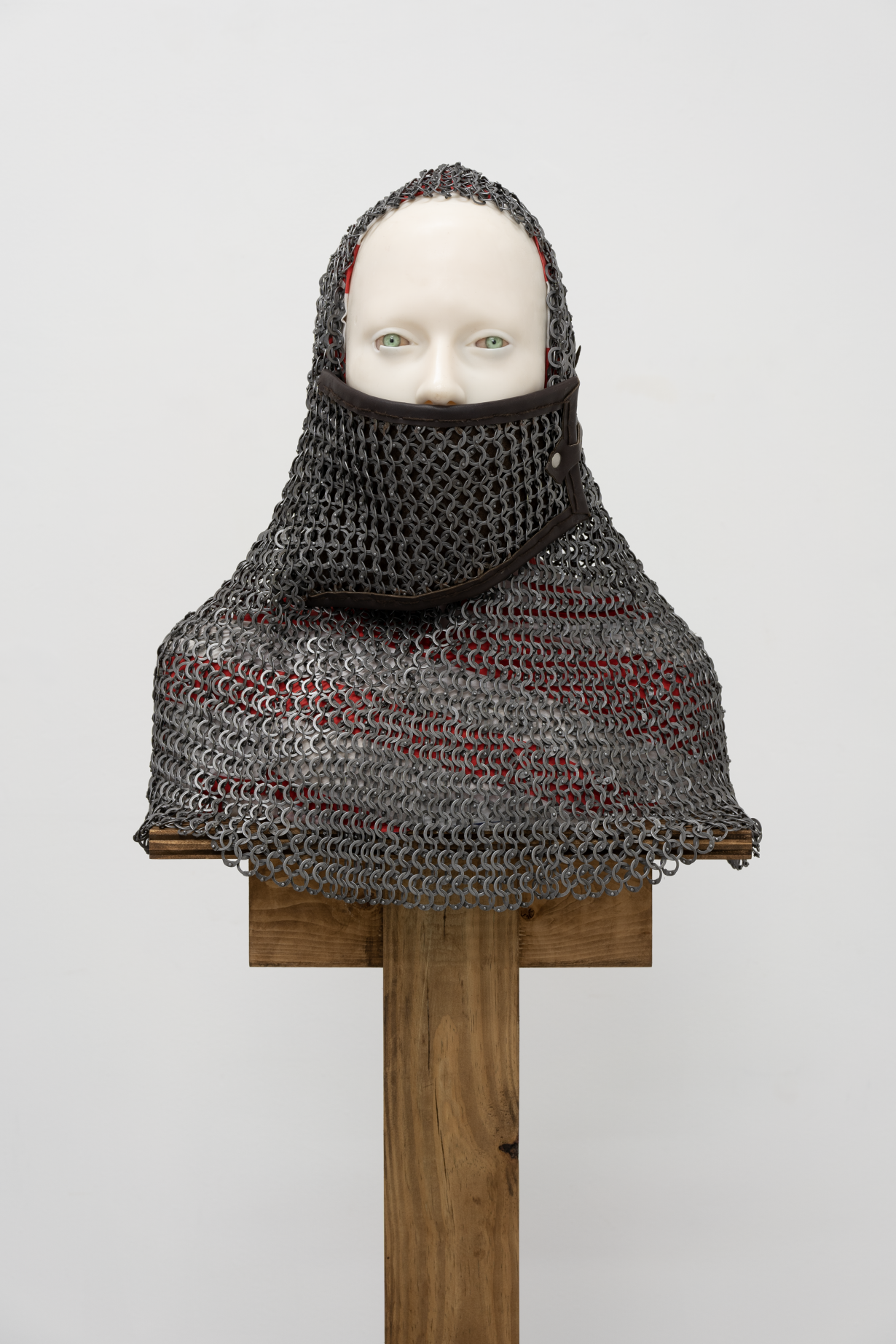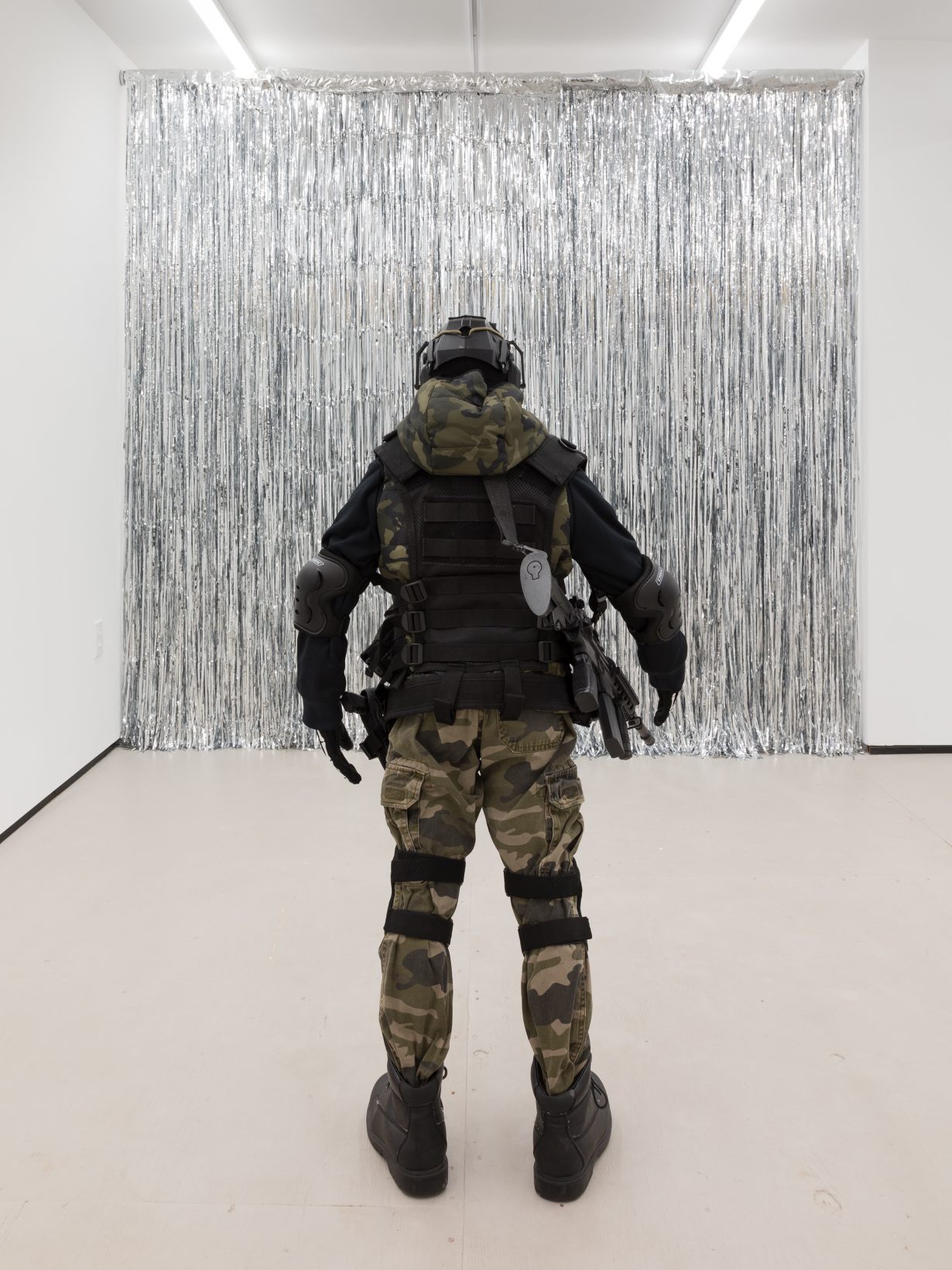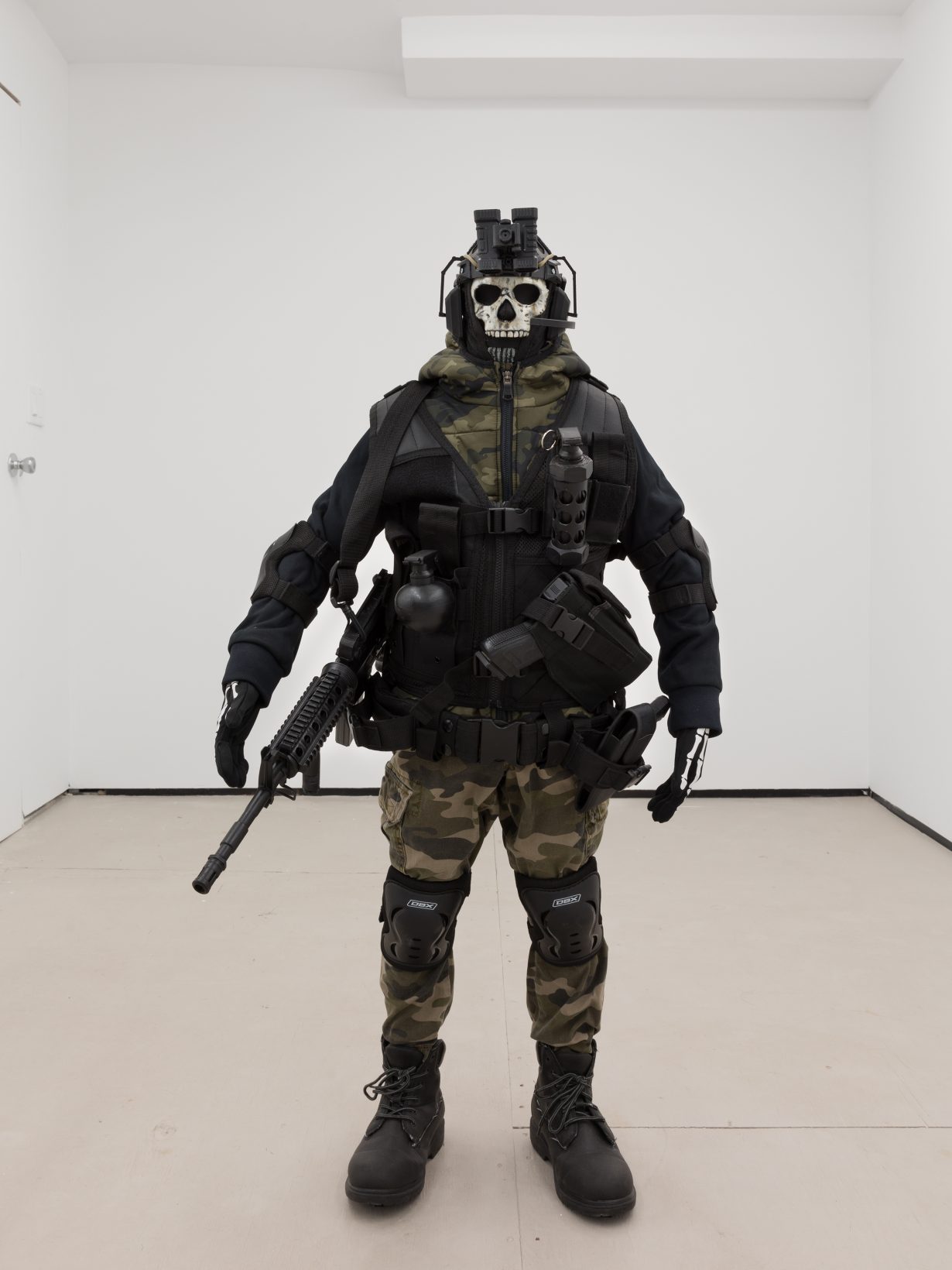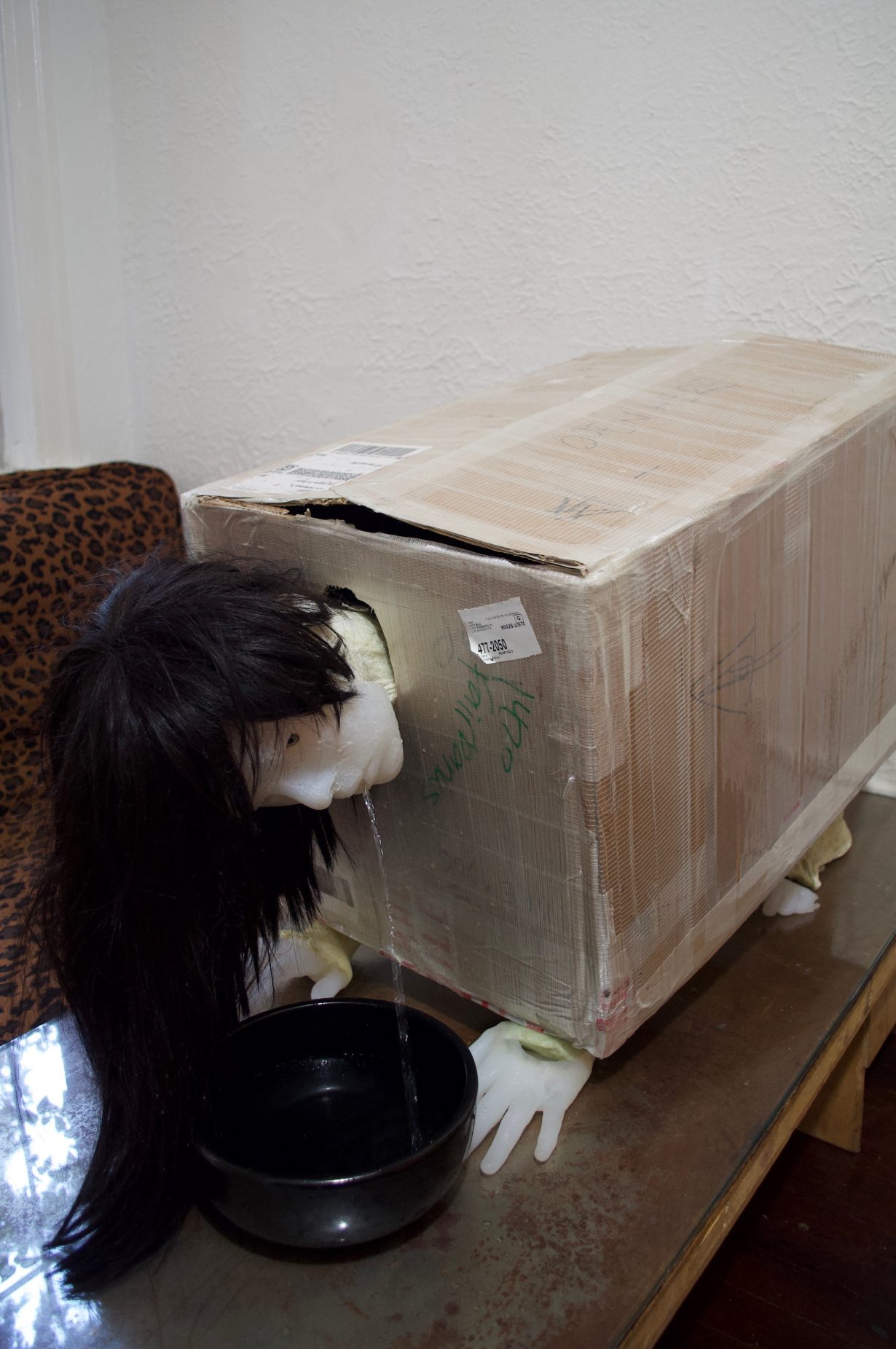Through kitbashing and the hacking of readymades, an artist explores what digital visual culture might look like in material form
Chicago-based artist Isabelle Frances McGuire reworks readymade objects to examine the ways in which the body itself is worked on, influenced and displaced by technology. Yes, as that implies, the real-life body is no longer the primary reference for recognising and modelling human form; instead, the contemporary experience of the body – the way it looks, moves and behaves – is mediated, in the developed world, by screen culture. Appropriating both recognisable and esoteric content – from religious icons and minor videogame characters to prehistoric monuments and high-tech weapons – McGuire’s sculptures are supplemented by motors, sensors and electronics as a physical stand-in for digitally circulated forms. Models of ships and bombs that have been 3D-printed dangle limply from the restrictive knots of lightbulb cords; recycled animatronics convulse repetitively like malfunctioning machines; and dolls and mannequins stand paralysed, overburdened by the heft of their cultural references. Deftly consolidating an ever-widening stream of open-source and second-hand content, McGuire’s work realises a profound sense of consternation as bodily agency for many is displaced through increasingly dispersed and advanced technological means.
The works assembled for McGuire’s recent solo exhibition LOOP, at Manhattan gallery King’s Leap Fine Art, employ the readymade as a physical means of parodying the act of repetition inherent to mass media culture; like an ‘original audio’ refrain on a social media reel divorced from its native source, online images are cropped, distorted and circulated, no longer bearing a resemblance to the real thing, but the image of that thing. Digital media flattens even as it multiplies. The contemporary readymade emerges in content that has already been doubled. Whether parodying the revered likeness of Elvis – whose real-life persona has been filtered through recycled video and image content in magazines, on the silver screen, in merchandise and now on social channels – or imaginary nonplayer characters (NPCs) who reappear across virtual gaming campaigns, McGuire’s sculptures accentuate the physicality of bodies that are manipulated on screens. Videogames, noted for their increasingly lifelike visuals and long-running franchises that regurgitate the same old story arcs, offer a particularly fruitful arena for McGuire to examine the flattening of visual culture amid an excess of sequels and reboots.

Interrogating the false equivalencies between real-life combat and first-person shooting games – as well as the cyclical feedback between game development and military technology – LOOP presented narrative cycles and repetitions as a manifestation of human behaviour interfacing with machines. Bust2{“Assassins Creed NPC”, “Normandy”, “New United States Flag”} (2023) comprises a wax bust cloaked by a flag and chainmail headdress. A motion sensor embedded in the sculpture triggers a cacophonous stream of battle bombs and cries, sourced from a Call of Duty: WWII (2017) scene depicting the US military storming Omaha Beach on D-Day. Elsewhere, a worn-down animatronic WowWee Alive Elvis bust performs on a ten-minute looped cycle. The head of Bust1{“Elvis”, “Modern WarFare II NVG”}, (2023), accessorised with night-vision goggles, twerks back and forth. His mouth widens and contracts as he recites canned quips in a lush drawl dampened by the squeak of ageing internal motors: “Are you looking for trouble? You came to the right place.” McGuire’s assemblages resemble ‘kitbashing’ – a method of combining open-source kits – real or digital – to create new forms. However, rather than propose something wholly new, McGuire’s mashups emphasise their disparate, recycled source materials. A lack of continuity – epitomised by Elvis’s iconic face obstructed by clunky toy goggles – is mirrored in the artwork titles, which bracket various references from gaming accessories to character names to geographic locations. These sculptures repeat what’s already been done, an attitude mirrored in the repetitive sounds and movements performed by the sculptures as they cycle through predetermined protocols.


In the gallery’s basement, McGuire envisions a scene in which content is still loading. A shimmering partition (RoomDivider1{“Loading Zone”, “Jasmine”}, 2023) creates a barrier between two sculptures. Referencing the interstitial zones in videogames where visual assets are still being rendered – picture a frozen or glitching screen due to poor internet connection – the flimsy barrier demands that the viewer slow down and pause. It’s a simple gesture in space that inserts a palpable moment of anticipation and disconnect in lieu of instant gratification. On one side of the divider, a diminutive, childsize model of Call of Duty operative Simon ‘Ghost’ Riley (SelfPortrait2{“Ghost”}, 2023) camps behind a column. Motionless, he faces the foil curtain, armed and ready to mark an unwitting target. On the other side, slumped on the floor, a feeble baby Yoda doll (SuperBaby2(Unmanned) {“The Child”, “Reborn”}, 2023) cries for help. Augmented by motion-responsive robotic components, the creature’s head shifts erratically, scanning its surroundings for something to respond to. These puerile figures stall for time, awaiting a sense of purpose or duty that may never come. One imagines a circle endlessly buffering.

McGuire’s sensitivity to the spatial and temporal dynamics of sculpture can be traced to their studies at the School of the Art Institute of Chicago, where they focused on the history of new media, technology and performance. Hindered by stage fright but eager to move beyond a practice mediated by screens, McGuire turned to tangible objects that could be animated in real time, developing a practice supported by technology but not defined by it. Earlier works made use of unstable materials like stale dough and preserved bugs that suggested imperceptibly slow processes of decay. Installations consisting of handmade miniature dolls implied the potential for action, even as the figures lay flaccid or stood frozen in a dynamic gesture.
Mechanical parts began to appear in 2020: Digesting Duck Entry Level Position is an abject drinking-fountain in the form of a vomiting figure, a silicone lifesize doll with pallid flesh and stringy black hair, crouching inside a beat-up cardboard box as it expels liquids. Inspired by an eighteenth-century French automaton of a gold-plated duck that would appear to consume, metabolise and excrete kernels, McGuire’s work animates the body’s basest functions. As liquid leaks from the figure’s mouth into cups or bowls, you get the uneasy sense that the work is dying. Notably, this body doesn’t move – it’s merely a receptacle through which fluids pass. The down-on-its-luck figure rehearses the icky discontents of the passive work required to keep the body alive.

Emblems of progress – propelled by technological advancements – obscure underlying narratives of failure. McGuire’s latest work, to be shown in a two-person exhibition at Detroit gallery What Pipeline, engages a kind of zombie media, putting into motion relics that are all but obsolete. Robot Donkey 2 (2023) is an animatronic donkey on a stage. Deaccessioned from Chicago’s Museum of Science and Industry, the pneumatically powered burro originally starred in an interactive museum display that walked visitors through the history of the Pioneer Zephyr, a high-speed, steel-clad streamliner famed for its dusk-to-dawn commute between Denver and Chicago from 1934 to 1960. At the museum, the automaton narrated the story of the train in a cartoonish, dopey voice; the animatronic references the real-life donkey, Zeph, that rode aboard the train as a mascot. The donkey and the train, the latter displacing the former with the expansion of the railroads to the West, are by now both out of work, artefacts fit for a museum. McGuire has further stifled the donkey by removing its voice box; the animal is silent, save for the twitching of its neck, mouth and eyes. In an ironic turn, the donkey now carries a set of amplifiers on its back, a displacement of sound from the inside to the outside. A nod to its heyday as a cargo-carrying tool, the animal now supports sound rather than makes it.
McGuire is scheduled to play alongside the donkey during an opening performance on 2 September with their band Suicide Moi. For McGuire, the donkey still has a use – something can still be eked out of it – but as a symbol, it resoundingly imparts a failure to keep up. Rather than model the future of society’s discontents, McGuire looks to an excess of past associations that stick briefly only to peel away. In McGuire’s art, one thing is always being superseded by another, rehearsing a sense of fatigue and obsession as the latest invention depreciates as quickly as it is dreamt up. The compulsion to repeat is perhaps the greatest defence against the inevitability of loss. McGuire clings to the humanity of failures and flops, conjuring clichés before they are ever uttered.
Work by Isabelle Frances McGuire is on show at What Pipeline, Detroit, through 14 October
